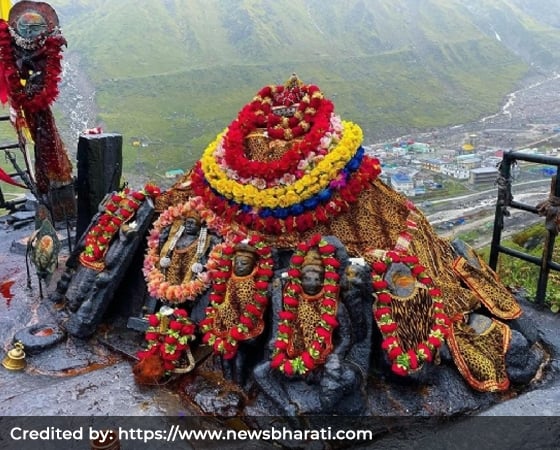Bhairav Temple
Click the 'Play' button to read out loud this webpage content
Introduction to Bhairav Temple
Bhairav Baba Mandir or Bhairav Temple is also known as Bhukund Bhairav Temple and is located 800 meters from Kedarnath. It lies on the eastern hill of the Himalayas in Uttarakhand. This old temple is dedicated to Baba Bhairav, the Kshetrapal (guardian) of the Kedarnath temple. It lies on the top of the hill, and pilgrims can reach it on foot. The deity Bhairav is a fierce manifestation of Shiva, who is associated with destruction.
Legend of Bhairav Temple

The legend of the origin of the Bhairav Temple is related to the story of Sati and Shiva. Sati, the daughter of King Daksha, wished to marry Shiva. Her father disapproved, as Shiva was only a Yogi and was residing with ghosts and forest animals. But Sati married Shiva, defying her father.
Daksha wanted to insult both Shiva and Sati. He conducted a Yagna and invited all except them. Sati went to the Yagna and asked him to apologize to Shiva. But he refused and insulted Shiva in front of his guests. Sati could not bear to see her husband being humiliated. She jumped into the Yagna fire and perished.
When Shiva came to know about it, he destroyed the Yagna and beheaded Daksha. Shiva carried Sati's charred body and wandered around the universe with uncontrollable anger that threatened to destroy the world. Vishnu used his Sudarshan Chakra (discus) to save the universe and cut Sati's body into pieces. The pieces of her body fell on the earth, and the places where they fell became the Shakti Peeths.
Shiva is said to guard each of these Shakti Peeths in the form of Bhairav. Each Shakti Peeth temple has a shrine for Bhairava.
The Architecture of Bhairav Temple
Devotees can reach Bhairav Temple from Kedarnath. Rawal or Rajput Shir Bhikund established the presiding deity in the Bhairav Temple before 3001 BC. Adi Shankaracharya was believed to have built it. The temple is in an open space, and there is no roof over Bhairav. The presiding deity is Bhairav in the idol form with Trishul (Trident), and his vahan (divine vehicle) is a dog. Pandavas worshipped at this temple. Pilgrims can see the idols of Pandavas here. The temple has an asbestos-roofed small area where pilgrims can sit and meditate. Colorful flags adorn the pathway of the temple. On festival occasions, the priests decorate the deities and perform special Poojas.
Festivals in Bhairav Temple
The Bhairav Temple celebrates Bhairav Ashtami and Maha Shivratri every year grandly. A huge crowd visits the temple during these festival days.
Benefits of Worshipping at Bhairav Temple
Bhairav is a fierce form of Shiva and has the power to protect devotees from evil forces and negative energies. There is a strong belief that if a devotee visits only the Kedarnath temple and not the Bhairav Temple, his darshan is considered incomplete.
How to Reach Bhairav Temple
By Road
Roads to the Bhairav Temple are well connected with the country's other cities so that pilgrims can access this temple by vehicle or bus.
By Rail
The nearest railway station from Bhairav Temple is Rishikesh railway station at a distance of 221 km.
By Air
The nearest airport is Jolly Grant Airport, Dehradun. It is a 256 km distance.
By Trekking
Pilgrims can trek to Bhairav temple from the famous Shri Kedarnath Jyotirlinga. It is about 1.5 km to the temple. The trekking journey starts from the right side door of the Baba Kedarnath Temple.
Bhairav Temple Timings
The Bhairav Temple remains open from 6.00 am to 8.00 pm.
Best Time to Visit Bhairav Temple
Summer is the best season to visit the Bhairav Temple. The climate will be warm as the temperature will be above 20˚c.
If you wish to have customized spiritual tours or pilgrimages arranged in India for yourself or for a group of people, please contact Brindavan Mystic Services
Email ID: [email protected]
Toll free: 1800 102 9098